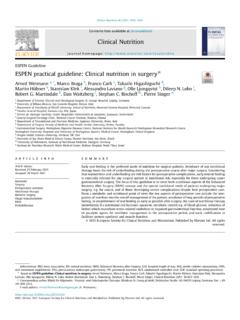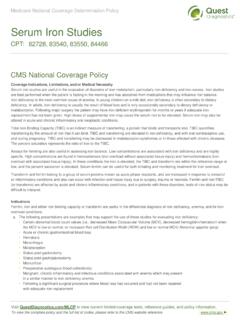Transcription of MANAGEMENT OF CHOLELITHIASIS & CHOLEDOCHOLITHIASIS
1 MANAGEMENT OF CHOLELITHIASIS & CHOLEDOCHOLITHIASIS Bharadwaj PGY III, Dept. of General Surgery The presence of gallstones in the gallbladder is called CHOLELITHIASIS . The presence of gallstones in the common bile duct is called CHOLEDOCHOLITHIASIS DEFINITION Effects of Gallstones In the gallbladder: Asymptomatic stones Biliary colic with periodicity Acute cholecystitis Chronic cholecystitis Empyema gallbladder Perforation causing biliary peritonitis or pericholecystitic abscess Mucocele of the gallbladder Limey gallbladder Gallstone ileus leading to small bowel obstruction Carcinoma gallbladder In the common bile duct(CBD): Obstructive jaundice Cholangitis Pancreatitis Mirizzi syndrome Current discussion.
2 Chronic cholecystitis Acute calculous cholecystitis Choledocholothiasis Aysmptomatic gallstones CLINICAL PRESENTATION Chronic cholecystitis Biliary colic a common misnomer because the pain is not colicky The pain is described as a bandlike tightness of the upper abdomen in the epigastrium or right upper quadrant constant pain that builds in intensity, and can radiate to the back, interscapular region, Attacks usually last for more than 1 hour but subsides by 24 hours; may be associated with nausea and vomiting. Bloating and belching 50% Intolerance to fatty meals Flatulent dyspepsia The physical examination usually normal if they are pain-free.
3 During an episode of biliary colic, mild right upper quadrant tenderness may be present. Acute calculous cholecystitis Right upper quadrant pain, similar in severity but much longer in duration than pain from previous episodes of biliary colic fever, nausea, and vomiting. On physical exam, right upper quadrant tenderness and guarding are usually present inferior to the right costal margin, distinguishing the episode from simple biliary colic. When inflammation spreads to the peritoneum, patients develop more diffuse tenderness, guarding and rigidity. A mass, the gallbladder and adherent omentum, is occasionally palpable, Murphy's sign, inspiratory arrest with deep palpation in the right upper quadrant, may also be present.
4 A mild leukocytosis is usually present (12,000-14,000 cells/mm3). mild elevations in: serum bilirubin (>4 mg/dL), alkaline phosphatase, transaminases, amylase may be present. CHOLEDOCHOLITHIASIS Common bile duct stones may be silent and are often discovered incidentally. In these patients, biliary obstruction is transient, and laboratory tests may be normal. Clinical features suspicious for biliary obstruction(obstructive/surgical jaundice) due to common bile duct stones: biliary colic, jaundice, pruritis Pale/clay coloured stools, and dark of the urine.
5 Vitamin deficiency Obstruction of bile flow also interferes with absorption of the fat-soluble vitamins A,D,E, and K Fever and chills may be present Charcot s triad - seen in CHOLEDOCHOLITHIASIS with ascending cholangitis : Fever, Rt. Upper quadrant pain, jaundice If untreated, may progress to septic shock Rey old s pentad: Charcot s triad + hypote sio + e tal status cha ges BLOOD INV: TLC increased Serum bilirubin (> mg/dL), serum aminotransferases raised alkaline phosphatase & gamma glutamyl transpeptidase are elevated (more than AST/ALT) URINALYSIS: Urine Bilirubin is increased.
6 Urobilinogen is negative. Aysmptomatic gallstones 10% of males and 20% of females Gallstones detected incidentally while performing USG abdomen for some other reasons. MANAGEMENT INVESTIGATIONS Laboratory investigations LFT s Hepatitis B&C viral serology Urine Imaging Non-invasive/ minimally invasive Invasive Imaging Non-invasive / minimally invasive Abdominal X-ray Oral cholecystogram Ultrasonography (US) Magnetic Resonance Cholangio-Pancreatography (MRCP) Cholescintigraphy Computerized Tomography (CT) Invasive Endoscopic Retrograde Cholangio-Pancreatography (ERCP) Endoscopic Ultrasound Percutaneous Transhepatic Cholangiography (PTC) Intraoperative cholangiography X-ray abdomen X-rays.
7 15% stones are radiopaque, May show Mercedes-Benz sign porcelain GB may be seen. Air in biliary tree(Pneumobilia) emphysematous GB wall. Ultrasonography Accurate Quick Inexpensive Easily available Operator dependent Suboptimal scan Ultrasonography Biliary calculi Size of GB Thickness of GB wall Inflammation around GB - Pericholecystic fluid, sonographic Murphy s. Size of CBD (Normal CBD diameter 6-8mm) Ultrasonography Intra and extra-hepatic biliary dilatation and level of obstruction. 70-95 % sensitive. 80-100 % specific. MRCP Non-invasive Contrast not required. Demonstrates Ductal obstruction Visualizes stones Strictures Other intra & extra ductal abnormalities Cholescintigraphy Technitium 99 (Tc99-IDA chelate complex).
8 HIDA/ PIPIDA/ DISIDA scan. Gallbladder visualized within 30min to 1 hour in absence of disease. Not visualized in Acute cholecystitis 97 % sensitive and 94 % specific. Diagnose obstruction. HIDA Bile leaks (detect and quantify). CBD obstruction appears as non visualization of small intestine. No external radiation exposure to the patient. Less helpful when the patient is fasting for more than 5 days, with a 40% false-positive rate. CT Scan Not useful in benign biliary disease. Useful when Carcinoma gallbladder is suspected Gall stones often not visualized. Cholecystitis is underdiagnosed.
9 Higher dose of radiation. Endoscopic Ultrasound Procedure: USG probe passed through an upper GI endoscope and kept in pylorus/duodenum area High frequency used - 20-40 Mhz Evaluates Pancreato-biliary system. Detection of microlithiasis CHOLEDOCHOLITHIASIS Evaluation of benign and malignant strictures. Detects regional lymphnodes Relationship to vascular structures. Endoscopic Ultrasound Advantages: High resolution imaging. Less invasive. No exposure to radiation. Aspiration of a cyst or FNAC. Disadvantages: Higher operator dependency. Cost and availability. Visualization is limited to 8 cm.
10 ERCP More of a therapeutic than diagnostic technique. ERCP Diagnostic Gold standard of imaging for biliary tree. Detects stones or malignant strictures Identifies the cause and level of obstruction Percutaneous Transhepatic Cholangiography (PTC) Percutaneous Transhepatic Cholangiography (PTC) More of a palliative technique. Bile ducts are cannulated directly. Demonstrates areas of stricture/obstruction. Effective in pts with a dilated biliary ductal system Indications: When ERCP fails or is not possible. Stenting for biliary drainage. Prior to biliary drainage procedure. Contraindications: bleeding tendency, Unfit for surgery, Hydatid Cysts, Ascites, CLD (chronic liver disease) TREATMENT ASYMPTOMATIC CHOLELITHIASIS Prophylactic cholecystectomy considered in high risk pool: Elderly diabetics Those who do not have immediate access to hospital Those from CA gallbladder belt UP & Bihar Pt with hemolytic anemias such as Sickle cell anemia Porcelain gall bladder Large gallstones (> ) Long common channel of bile and pancreatic ducts bariatric surgery Prior to transplantation life threatening infection in the immunocompromised.



